幼儿英语教育论文参考文献
幼儿园大班英语教育参考文献 幼儿园英语教育
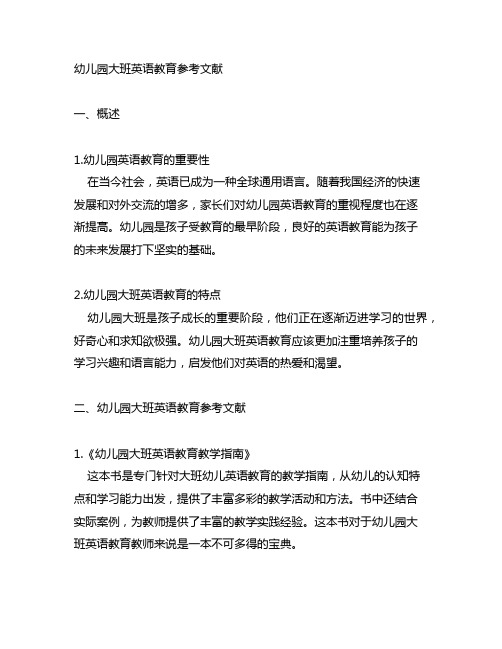
幼儿园大班英语教育参考文献一、概述1.幼儿园英语教育的重要性在当今社会,英语已成为一种全球通用语言。
随着我国经济的快速发展和对外交流的增多,家长们对幼儿园英语教育的重视程度也在逐渐提高。
幼儿园是孩子受教育的最早阶段,良好的英语教育能为孩子的未来发展打下坚实的基础。
2.幼儿园大班英语教育的特点幼儿园大班是孩子成长的重要阶段,他们正在逐渐迈进学习的世界,好奇心和求知欲极强。
幼儿园大班英语教育应该更加注重培养孩子的学习兴趣和语言能力,启发他们对英语的热爱和渴望。
二、幼儿园大班英语教育参考文献1.《幼儿园大班英语教育教学指南》这本书是专门针对大班幼儿英语教育的教学指南,从幼儿的认知特点和学习能力出发,提供了丰富多彩的教学活动和方法。
书中还结合实际案例,为教师提供了丰富的教学实践经验。
这本书对于幼儿园大班英语教育教师来说是一本不可多得的宝典。
2.《游戏式教学在幼儿园大班英语教育中的应用研究》这篇研究论文探讨了游戏式教学在幼儿园大班英语教育中的应用及其效果。
研究发现,通过游戏式教学,孩子们的学习兴趣得到了极大的激发,他们能够更加主动地参与到学习中来。
通过游戏,孩子们的语言表达能力和语感也得到了有效的提升。
3.《家长参与幼儿园大班英语教育的作用探究》这篇论文研究了家长在幼儿园大班英语教育中的作用,发现了家长参与对孩子的英语学习有着积极的影响。
通过家长和学校的紧密合作,孩子们能够得到更好的英语学习环境和支持,家长的积极参与更能够激发孩子学习英语的兴趣和潜能。
4.《幼儿园大班英语教育课程设计与实施》这本书系统地介绍了幼儿园大班英语教育课程的设计和实施方案。
书中提出了具体的教学内容和方法,同时还结合了实际幼儿园的案例进行了详细的剖析和讨论。
这本书能够让教师们更加科学地制定教学计划和教学方法,有效地提高教学质量。
5.《幼儿园大班英语教育教学评价实践》这篇论文通过对幼儿园大班英语教育教学评价的实际案例进行研究,提出了一些切实可行的评价方法和策略。
幼儿安全教育英文文献(3篇)
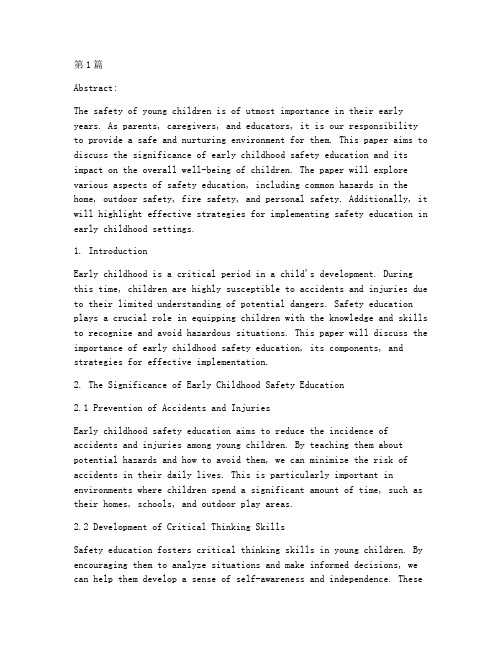
第1篇Abstract:The safety of young children is of utmost importance in their early years. As parents, caregivers, and educators, it is our responsibility to provide a safe and nurturing environment for them. This paper aims to discuss the significance of early childhood safety education and its impact on the overall well-being of children. The paper will explore various aspects of safety education, including common hazards in the home, outdoor safety, fire safety, and personal safety. Additionally, it will highlight effective strategies for implementing safety education in early childhood settings.1. IntroductionEarly childhood is a critical period in a child's development. During this time, children are highly susceptible to accidents and injuries due to their limited understanding of potential dangers. Safety education plays a crucial role in equipping children with the knowledge and skills to recognize and avoid hazardous situations. This paper will discuss the importance of early childhood safety education, its components, and strategies for effective implementation.2. The Significance of Early Childhood Safety Education2.1 Prevention of Accidents and InjuriesEarly childhood safety education aims to reduce the incidence of accidents and injuries among young children. By teaching them about potential hazards and how to avoid them, we can minimize the risk of accidents in their daily lives. This is particularly important in environments where children spend a significant amount of time, such as their homes, schools, and outdoor play areas.2.2 Development of Critical Thinking SkillsSafety education fosters critical thinking skills in young children. By encouraging them to analyze situations and make informed decisions, we can help them develop a sense of self-awareness and independence. Theseskills are essential not only for their safety but also for theiroverall growth and development.2.3 Building Confidence and ResilienceWhen children are equipped with the knowledge and skills to handle hazardous situations, they develop a sense of confidence and resilience. This confidence allows them to face challenges and adapt to new environments, which is crucial for their emotional and social development.3. Components of Early Childhood Safety Education3.1 Home SafetyHome safety is a crucial aspect of early childhood safety education. It involves identifying and eliminating potential hazards in the home environment. Some key areas to focus on include:- Electrical safety: Teach children about the dangers of electrical outlets, cords, and appliances.- Poison prevention: Store toxic substances out of reach and teach children about the importance of not ingesting unfamiliar objects.- Falls prevention: Ensure that stairs are safe, secure furniture is anchored, and windows have proper guards.3.2 Outdoor SafetyOutdoor safety education is essential for children who spend time in playgrounds, parks, and other outdoor settings. This includes:- Playground safety: Teach children about proper use of playground equipment, the importance of supervised play, and how to avoid dangerous situations.- Traffic safety: Educate children about pedestrian and bicycle safety, including the use of crosswalks, traffic signals, and proper behavior while on the road.3.3 Fire SafetyFire safety is a critical component of early childhood safety education. It involves teaching children about the dangers of fire and how to respond in case of an emergency. Key points include:- Recognizing smoke and fire alarms: Teach children to identify the sound of smoke and fire alarms and understand their purpose.- Escape routes: Discuss and practice escape routes from their home and other buildings.- Stop, drop, and roll: Teach children the importance of stopping, dropping to the ground, covering their face, and rolling over if their clothing catches fire.3.4 Personal SafetyPersonal safety education focuses on teaching children how to protect themselves from potential dangers, such as stranger danger, bullying, and abuse. Key points include:- Stranger danger: Teach children to trust their instincts and not to approach or accept gifts from strangers.- Bullying prevention: Educate children about the importance of standing up against bullying and seeking help when necessary.- Abuse prevention: Discuss the concept of privacy and teach children to tell a trusted adult if they feel uncomfortable or unsafe.4. Strategies for Implementing Early Childhood Safety Education4.1 Engage Children in Active LearningActive learning techniques, such as role-playing, games, and hands-on activities, can make safety education more engaging and memorable for young children. These methods allow them to learn through experience and develop a deeper understanding of safety concepts.4.2 Collaborate with Parents and CaregiversParents and caregivers play a vital role in early childhood safety education. By collaborating with them, educators can reinforce safetylessons and ensure consistency in the home environment. This may include providing parents with resources, hosting workshops, and maintaining open communication channels.4.3 Continuously Assess and Adapt Safety Education ProgramsRegularly assess the effectiveness of safety education programs and make necessary adjustments to meet the evolving needs of young children. This may involve incorporating new topics, updating resources, and seeking feedback from children, parents, and caregivers.5. ConclusionEarly childhood safety education is crucial for the well-being of young children. By teaching them about potential hazards and how to avoid them, we can reduce the risk of accidents and injuries, foster criticalthinking skills, and build confidence and resilience. Implementing effective safety education strategies in early childhood settings requires collaboration among parents, caregivers, and educators. By prioritizing safety education, we can create a safer and healthier environment for young children to grow and thrive.第2篇IntroductionChild safety is a crucial concern for parents, educators, and policymakers. Accidents and injuries among young children are prevalent, and early childhood safety education plays a vital role in reducingthese risks. This article aims to provide a comprehensive overview of early childhood safety education, including its importance, effective strategies, and implementation challenges.I. Importance of Early Childhood Safety Education1. Preventing accidents and injuries: Early childhood is a period when children are most vulnerable to accidents and injuries. Safety education can help children develop awareness and skills to prevent such incidents.2. Fostering healthy development: Safety education contributes to children's overall development by promoting problem-solving, critical thinking, and decision-making skills.3. Reducing healthcare costs: By preventing accidents and injuries, early childhood safety education can decrease the financial burden on families and healthcare systems.4. Enhancing parent-child communication: Safety education encourages parents and caregivers to engage in open discussions with children about potential hazards and protective measures, fostering stronger relationships.II. Effective Strategies for Early Childhood Safety Education1. Developmentally appropriate content: Safety education should be tailored to children's age, cognitive level, and physical abilities. Use simple language, visuals, and hands-on activities to convey safety messages.2. Parental involvement: Parents and caregivers should be actively involved in their children's safety education. Provide them with resources and training to support their efforts at home.3. School and community collaboration: Collaboration between schools, parents, and local communities is essential for effective safety education. Establish partnerships to implement coordinated programs and share resources.4. Curricula and lesson plans: Develop comprehensive curricula and lesson plans that cover various safety topics, such as fire safety, water safety, traffic safety, and poison prevention. Incorporate interactive activities, role-playing, and practical demonstrations.5. Role models: Encourage adults, including teachers, parents, and community members, to serve as positive role models by practicing safe behaviors and discussing safety concerns with children.6. Evaluation and continuous improvement: Regularly assess the effectiveness of safety education programs and make adjustments asneeded. Collect data on accident rates, parent and child satisfaction, and skill development to measure progress.III. Implementation Challenges and Solutions1. Resource allocation: Limited resources can hinder the implementation of effective safety education programs. Seek funding from government agencies, private organizations, and community partners to support program development and implementation.2. Teacher training: Ensure that teachers and caregivers receive adequate training on safety education principles and practices. Offer workshops, seminars, and ongoing support to enhance their skills.3. Parental engagement: Encourage parental involvement through newsletters, workshops, and home visits. Provide parents with practical tips and resources to reinforce safety messages at home.4. Cultural and linguistic considerations: Recognize and addresscultural and linguistic barriers to ensure that safety education is accessible to all children. Develop multilingual materials and collaborate with cultural organizations.5. Sustaining long-term commitment: Establish clear goals and expectations for safety education programs and promote a long-term commitment from stakeholders. Monitor progress and celebrate successes to maintain momentum.ConclusionEarly childhood safety education is essential for preventing accidents and injuries among young children. By adopting effective strategies and addressing implementation challenges, we can create a safer environment for children and promote their healthy development. Collaboration between parents, educators, and policymakers is crucial to ensure the success of safety education initiatives and build a safer future for our children.第3篇Abstract:This paper aims to discuss the significance of early childhood safety education and its role in shaping a safe and secure environment for young children. It highlights the various aspects of safety education, including fire safety, road safety, water safety, and personal safety. The paper also emphasizes the importance of parent-child communication, teacher-child interaction, and community involvement in promoting a safe environment for young children.1. IntroductionEarly childhood is a critical period in a child's development, where they are highly susceptible to accidents and injuries. Therefore, it is essential to provide them with adequate safety education to prevent such incidents. This paper aims to explore the importance of early childhood safety education, its various components, and the strategies to implement it effectively.2. Importance of Early Childhood Safety Education2.1 Preventing Accidents and InjuriesEarly childhood safety education plays a vital role in preventing accidents and injuries among young children. By equipping them with knowledge and skills, children can recognize potential hazards and avoid dangerous situations. This, in turn, reduces the risk of accidents and injuries, ensuring a safe and healthy environment for children.2.2 Fostering a Safe EnvironmentA safe environment is crucial for the overall development of young children. Early childhood safety education helps in creating a safe atmosphere where children can explore, learn, and grow without fear. It instills in them a sense of security, which is essential for their emotional and psychological well-being.2.3 Promoting Lifelong LearningSafety education in early childhood lays the foundation for lifelong learning. By acquiring safety skills and knowledge at a young age, children are more likely to adopt safe behaviors throughout their lives. This promotes a culture of safety in society, reducing the risk of accidents and injuries for all individuals.3. Components of Early Childhood Safety Education3.1 Fire SafetyFire safety education is essential for young children, as they are more vulnerable to fire-related accidents. This component of safety education includes teaching children about fire hazards, fire escape plans, and the importance of fire alarms. Activities such as fire drills and fire safety games can help children understand the importance of fire safety.3.2 Road SafetyRoad safety education is crucial for young children, as they are often accompanied by adults while crossing roads. This component includes teaching children about traffic rules, pedestrian safety, and the importance of wearing seat belts. Interactive activities, such as playing road safety games and role-playing, can help children understand road safety concepts.3.3 Water SafetyWater safety education is vital for children who live near water bodies or are exposed to swimming pools. This component includes teaching children about water hazards, drowning prevention, and the importance of adult supervision. Activities such as water safety songs and pool safety drills can help children develop water safety skills.3.4 Personal SafetyPersonal safety education is essential for young children, as they are more susceptible to abuse and exploitation. This component includes teaching children about stranger danger, personal boundaries, and the importance of reporting any inappropriate behavior. Interactiveactivities, such as personal safety stories and role-playing, can help children understand personal safety concepts.4. Strategies for Implementing Early Childhood Safety Education4.1 Parent-Child CommunicationEffective communication between parents and children is crucial for promoting safety education. Parents should engage in regular conversations with their children about safety, share their own experiences, and encourage open dialogue. This helps children develop a sense of trust and confidence in their parents, making them more receptive to safety education.4.2 Teacher-Child InteractionTeachers play a vital role in early childhood safety education. They should incorporate safety topics into their daily lessons, conduct safety activities, and provide a safe and supportive learning environment. Regular communication between teachers and parents can help ensure a consistent approach to safety education.4.3 Community InvolvementCommunity involvement is essential for promoting a safe environment for young children. Schools, parents, and local authorities should collaborate to organize safety workshops, distribute safety materials, and implement safety programs. This creates a collective responsibility for the well-being of children in the community.5. ConclusionEarly childhood safety education is a crucial component of a child's development, ensuring their safety and well-being. By focusing on various aspects of safety education, such as fire safety, road safety, water safety, and personal safety, we can create a safe and secure environment for young children. Effective strategies, including parent-child communication, teacher-child interaction, and community involvement, are essential for implementing early childhood safety education successfully. It is our collective responsibility toprioritize safety education and ensure that children grow up in a safe and nurturing environment.。
儿童英语论文范文10篇(全文)

儿童英语论文范文10篇(全文)儿童英语论文范文第1篇众所周知,英语作为通向世界的大门具有很重要的意义。
2022年奥运会在中国的举行,使得英语在今后的若干年都会是最为时尚和鉴定人们素质的最为重要的标准之一。
因此,母语非英语的人熟练掌握英语便成为现代人必备的素质。
另外对于幼儿到底应不应该学习外语,虽然还存在着争论,但是越来越多的专家表示幼儿确实有学好外语的潜力,并有研究表明幼儿期学英语比成年后再学习的效果好很多。
因此探索出一种切实有效的幼儿学习英语的方法是十分必要的。
加拿大圣·兰伯特的法语浸入式教学在20世纪70年代末取得了很大效果,引起了全国范围的轰动。
近十多年来,加拿大的法语浸入式教育已经成为许多国家效仿的榜样。
我国在1997年,引入了加拿大第二语言浸入式教学模式。
由我国对外贸易经济部、加拿大联邦政府国际开发署、我国国家教委和加拿大大学联合会共同批准,由加拿大联邦国际开发署资助的“中加大学合作巩固项目”于1996年启动。
其中一个项目为“妇女和少数民族教育研究”,共有两国八所大学为项目单位。
在这个项目的少数民族双语研究中,加方专家系统地引进了加拿大各语种第二语言浸入式教育的理论和实践。
此项目先后在西安、广州、深圳、江门、惠州等城市的十余所幼儿园进行,同时我国许多教育研究机构也开始探索英语浸入式教学法在我国的推广。
那么这种教学方法是否有效?是否适合中国?我国是否应该全面推广浸入式教学模式?本文将对以上问题进行详细论述。
二、概念的界定英语浸入式(EnglishImmersion)教学:是指用英语作为教学语言的教学与课程模式,即儿童在园的全部或一半时间内“浸泡”在英语环境中;教师只用英语面对幼儿,不用母语做中介,而且部分学科课程也要用英语来讲授。
英语不仅是学习的内容,而且是学习的工具。
①这种模式是借鉴加拿语浸入式的成功经验,在第二语言习得理论的基础上,结合生理学、语言学、心理学的研究成果创造的一种具有中国本土化特色的新的幼儿英语教学模式。
幼儿园小班语言教育参考文献
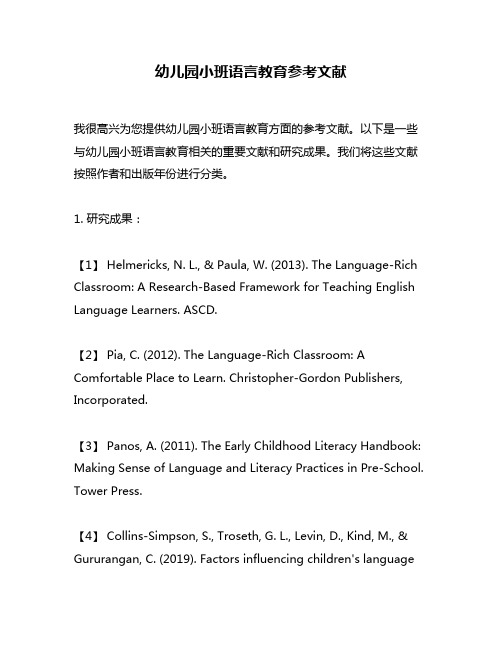
幼儿园小班语言教育参考文献我很高兴为您提供幼儿园小班语言教育方面的参考文献。
以下是一些与幼儿园小班语言教育相关的重要文献和研究成果。
我们将这些文献按照作者和出版年份进行分类。
1. 研究成果:【1】 Helmericks, N. L., & Paula, W. (2013). The Language-Rich Classroom: A Research-Based Framework for Teaching English Language Learners. ASCD.【2】 Pia, C. (2012). The Language-Rich Classroom: A Comfortable Place to Learn. Christopher-Gordon Publishers, Incorporated.【3】 Panos, A. (2011). The Early Childhood Literacy Handbook: Making Sense of Language and Literacy Practices in Pre-School. Tower Press.【4】 Collins-Simpson, S., Troseth, G. L., Levin, D., Kind, M., & Gururangan, C. (2019). Factors influencing children's languagedevelopment in preschool classrooms. Early Childhood Research Quarterly, 46, 197-210.【5】 Neuman, S. B., & Dickinson, D. K. (2015). Handbook of Early Literacy Research. Guilford Publications.【6】 Sulzby, E., & Teale, W. H. (1996). Emergent literacy: Writing and reading (Vol. 3). Abilene Christian University Press.【7】 Vygotsky, L. S., & Vygotskiĭ, L. S. (1986). Thought and language (Vol. 14). MIT press.【8】 Christie, J. F. (2014). Play and pedagogy in early childhood: Bending the rules. Routledge.【9】 Snow, C. E., & Dickinson, D. K. (Eds.). (2016). Handbook of early childhood literacy. Guilford Publications.2. 研究论文:【1】 Whitehurst, G. J., & Lonigan, C. J. (1998). Child development and emergent literacy. Child development, 69(3), 848-872.【2】 Dickinson, D. K., & Tabors, P. O. (Eds.). (2020). Beginning literacy with language: Young children learning at home and school. Paul H Brookes Publishing.【3】 Zembylas, M., & Vrasidas, C. (Eds.). (2005). Multiple perspectives on problem solving and learning in the digital age. IGI Global.【4】 Hart, B., & Risley, T. R. (1995). Meaningful differences in the everyday experience of young American children. Paul H Brookes Publishing.【5】 Yaden, D. B., & Barbieri, C. (2020). Supporting young children's language and literacy development through interactive writing. Early Childhood Education Journal, 48(4), 493-503.【6】 Kaderavek, J. N., & Sulzby, E. (2002). A play and language intervention for two-year-old children. Language, speech, and hearing services in schools, 33(2), 153-165.【7】 Sulzby, E. (1985). Children's emergent reading of favoritestorybooks: A developmental study. Reading research quarterly, 120-134.【8】 Tyack, D., & Cuban, L. (1995). Tinkering toward utopia: A century of public school reform. Harvard University Press.3. 幼儿园语言教育指南和手册:【1】重庆市教育局. (2014). 幼儿园语言教育指南. 语文月报社.【2】刘光明. (2011). 幼儿园语文教育指导手册. 人民教育出版社.【3】薛智泉. (2008). 幼儿园语言教育指南. 语文月报社.【4】杨乃文. (2014). 幼儿园语文教学指南. 广西师范大学出版社.【5】方凤斯. (2016). 幼儿园语言教育指导手册. 北京师范大学出版社.以上是一些关于幼儿园小班语言教育的重要文献和研究成果,这些文献包括专业研究、教育理论、实证研究等,可以提供给教师和研究人员作为参考。
幼儿园英语教育参考文献
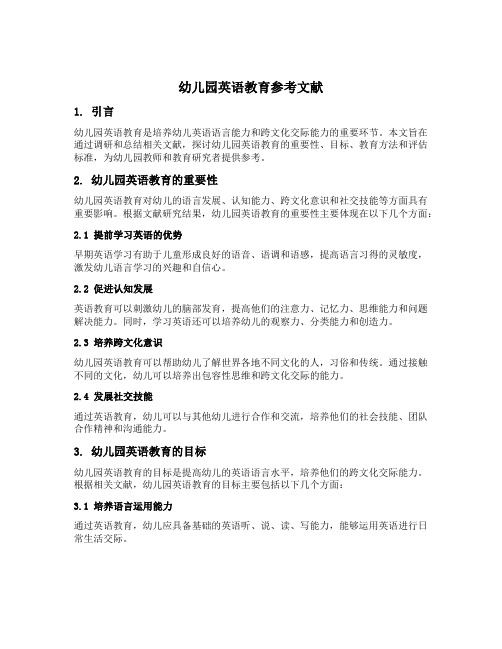
幼儿园英语教育参考文献1. 引言幼儿园英语教育是培养幼儿英语语言能力和跨文化交际能力的重要环节。
本文旨在通过调研和总结相关文献,探讨幼儿园英语教育的重要性、目标、教育方法和评估标准,为幼儿园教师和教育研究者提供参考。
2. 幼儿园英语教育的重要性幼儿园英语教育对幼儿的语言发展、认知能力、跨文化意识和社交技能等方面具有重要影响。
根据文献研究结果,幼儿园英语教育的重要性主要体现在以下几个方面:2.1 提前学习英语的优势早期英语学习有助于儿童形成良好的语音、语调和语感,提高语言习得的灵敏度,激发幼儿语言学习的兴趣和自信心。
2.2 促进认知发展英语教育可以刺激幼儿的脑部发育,提高他们的注意力、记忆力、思维能力和问题解决能力。
同时,学习英语还可以培养幼儿的观察力、分类能力和创造力。
2.3 培养跨文化意识幼儿园英语教育可以帮助幼儿了解世界各地不同文化的人,习俗和传统。
通过接触不同的文化,幼儿可以培养出包容性思维和跨文化交际的能力。
2.4 发展社交技能通过英语教育,幼儿可以与其他幼儿进行合作和交流,培养他们的社会技能、团队合作精神和沟通能力。
3. 幼儿园英语教育的目标幼儿园英语教育的目标是提高幼儿的英语语言水平,培养他们的跨文化交际能力。
根据相关文献,幼儿园英语教育的目标主要包括以下几个方面:3.1 培养语言运用能力通过英语教育,幼儿应具备基础的英语听、说、读、写能力,能够运用英语进行日常生活交际。
3.2 培养文化意识幼儿园英语教育应当使幼儿了解和尊重其他文化,并培养他们的跨文化沟通能力。
幼儿应当有能力使用英语了解和交流来自不同文化的信息。
3.3 培养学习策略幼儿应当学会运用不同的学习策略,如观察、模仿和创造,提高自主学习的能力。
4. 幼儿园英语教育的教育方法幼儿园英语教育应采用多元化、趣味性和互动性的教育方法,激发幼儿的学习兴趣和积极性。
以下是一些常见的幼儿园英语教育教育方法:4.1 游戏教学法游戏是幼儿喜爱的活动,可以通过游戏引导幼儿学习英语。
幼儿园小班语言教学活动设计研究外文参考文献
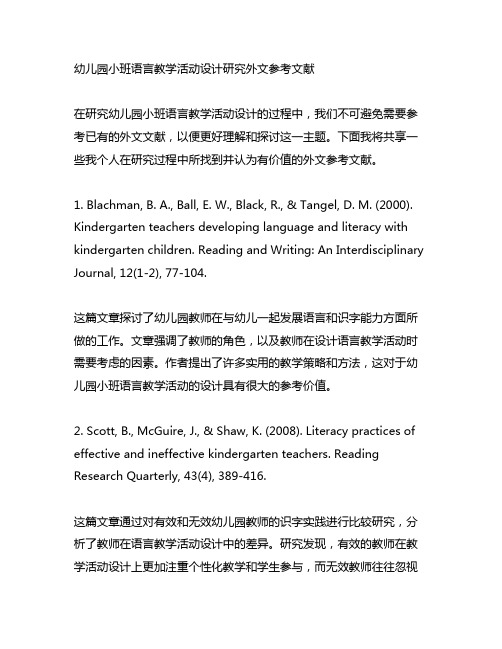
幼儿园小班语言教学活动设计研究外文参考文献在研究幼儿园小班语言教学活动设计的过程中,我们不可避免需要参考已有的外文文献,以便更好理解和探讨这一主题。
下面我将共享一些我个人在研究过程中所找到并认为有价值的外文参考文献。
1. Blachman, B. A., Ball, E. W., Black, R., & Tangel, D. M. (2000). Kindergarten teachers developing language and literacy with kindergarten children. Reading and Writing: An Interdisciplinary Journal, 12(1-2), 77-104.这篇文章探讨了幼儿园教师在与幼儿一起发展语言和识字能力方面所做的工作。
文章强调了教师的角色,以及教师在设计语言教学活动时需要考虑的因素。
作者提出了许多实用的教学策略和方法,这对于幼儿园小班语言教学活动的设计具有很大的参考价值。
2. Scott, B., McGuire, J., & Shaw, K. (2008). Literacy practices of effective and ineffective kindergarten teachers. Reading Research Quarterly, 43(4), 389-416.这篇文章通过对有效和无效幼儿园教师的识字实践进行比较研究,分析了教师在语言教学活动设计中的差异。
研究发现,有效的教师在教学活动设计上更加注重个性化教学和学生参与,而无效教师往往忽视了这些方面。
这对于我们设计幼儿园小班语言教学活动时提供了很好的借鉴和警示。
3. Neuman, S. B., & Roskos, K. (1993). Language and literacy learning in the early years: An integrated approach. Allyn & Bacon.这本书系统介绍了幼儿园阶段语言和识字学习的整体方法。
中西方儿童教育的英文参考文献
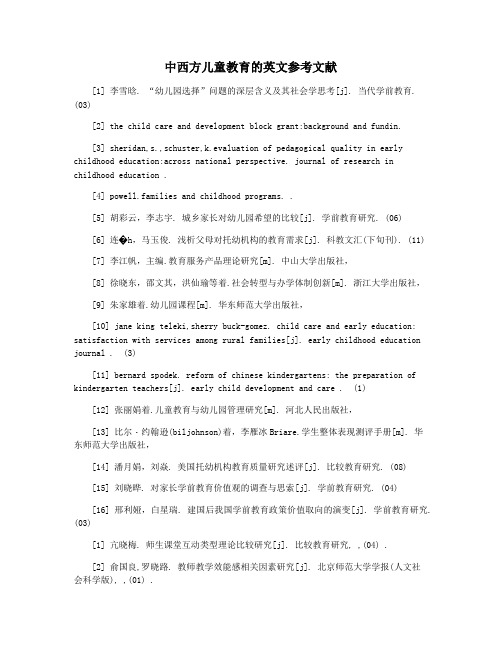
中西方儿童教育的英文参考文献[1] 李雪晗. “幼儿园选择”问题的深层含义及其社会学思考[j]. 当代学前教育. (03)[2] the child care and development block grant:background and fundin.[3] sheridan,s.,schuster,k.evaluation of pedagogical quality in early childhood education:across national perspective. journal of research in childhood education .[4] powell.families and childhood programs. .[5] 胡彩云,李志宇. 城乡家长对幼儿园希望的比较[j]. 学前教育研究. (06)[6] 连�h,马玉俊. 浅析父母对托幼机构的教育需求[j]. 科教文汇(下旬刊). (11)[7] 李江帆,主编.教育服务产品理论研究[m]. 中山大学出版社,[8] 徐晓东,邵文其,洪仙瑜等着.社会转型与办学体制创新[m]. 浙江大学出版社,[9] 朱家雄着.幼儿园课程[m]. 华东师范大学出版社,[10] jane king teleki,sherry buck-gomez. child care and early education: satisfaction with services among rural families[j]. early childhood education journal . (3)[11] bernard spodek. reform of chinese kindergartens: the preparation of kindergarten teachers[j]. early child development and care . (1)[12] 张丽娟着.儿童教育与幼儿园管理研究[m]. 河北人民出版社,[13] 比尔・约翰逊(biljohnson)着,李雁冰Briare.学生整体表现测评手册[m]. 华东师范大学出版社,[14] 潘月娟,刘焱. 美国托幼机构教育质量研究述评[j]. 比较教育研究. (08)[15] 刘晓晔. 对家长学前教育价值观的调查与思索[j]. 学前教育研究. (04)[16] 邢利娅,白星瑞. 建国后我国学前教育政策价值取向的演变[j]. 学前教育研究.(03)[1] 亢晓梅. 师生课堂互动类型理论比较研究[j]. 比较教育研究, ,(04) .[2] 俞国良,罗晓路. 教师教学效能感相关因素研究[j]. 北京师范大学学报(人文社会科学版), ,(01) .[3] 辛涛,申继亮. 论教师的教育观念[j]. 北京师范大学学报(社会科学版), ,(01) .[4] 伊文婷. 师范生教师职业信仰的近况、理由与对策[j]. 福建教育学院学报, ,(04) .[5] 俞国良,辛力行,林崇德. 思考训练就是提升教师素质的有效途径[j]. 高等师范教育研究, ,(04) .[6] 林正范,徐丽华. 对教师研究的认识[j]. 教师教育研究, ,(02) .[7] 高潇怡,庞丽娟. 教师的儿童自学观与其教育的关系研究[j]. 教师教育研究, ,(03) .[8] 任淑萍. 新课标下历史教师的转变[j]. 晋东南师范专科学校学报, ,(03) .[9] 史献平. 教师信仰:实行素质教育的内动力[j]. 江苏教育学院学报(社会科学版), ,(01) .[10] 辛涛,申继亮,林崇德. 教师自我效能感与学校因素关系的研究[j]. 教育研究, ,(10) .[11] 石中英.论教育课堂教学的逻辑[j]. 教育研究, ,(01) .[12] 肖川. 作为理想主义者的'教师[j]. 辽宁教育, ,(z1) .[13] 刘莉,杨艳芳. 教师教育信念研究综述[j]. 内蒙古师范大学学报(教育科学版), ,(12) .[14] 黄乾玉. 论教师的教育信仰及教师的教育幸福[j]. 黔东南民族师范高等专科学校学报, ,(01) .[15] 吕国光,王嘉毅. 中小学教师新课程信念的调查研究[j]. 当代教育科学, ,(13) .[16] 姜美玲. 课程革新情境中的教师信念与教学实践:叙事探究[j]. 当代教育科学, ,(20) .[17] 王永跃. 从支配至积极支持:建构主义视野中的教师[j]. 陕西师范大学学报(哲学社会科学版), ,(s1) .[18] 康武. 信念――数学教师的方向性不足[j]. 数学教育学报, ,(02) .[19] 林智中,张爽. 如何通过质化研究探究教师的信念[j]. 全球教育展望未来, ,(08) .[20] 任永泽. 我们现代需要样的儿童观[j]. 现代教育论丛, ,(04) .。
幼儿英语论文参考文献[Word文档]
![幼儿英语论文参考文献[Word文档]](https://img.taocdn.com/s3/m/7d6a6f0f11a6f524ccbff121dd36a32d7375c7c6.png)
幼儿英语论文参考文献本文档格式为WORD,感谢你的阅读。
最新最全的学术论文期刊文献年终总结年终报告工作总结个人总结述职报告实习报告单位总结演讲稿幼儿英语论文参考文献撰写毕业论文对于培养学生初步的科学研究能力,提高其综合运用所学知识分析问题、解决问题能力有着重要意义。
下面是小编为大家提供的关于幼儿英语论文的,内容如下:【幼儿英语论文参考文献一】[1] 高敏.幼儿英语教育[M].上海:华东师范大学出版社,2007[2] Flege(1987).A critical period for learning to pronounce foreign language .Applied Linguistics.1993.[3] [意大利]蒙台梭利.任代文主译校.蒙台梭利幼儿教育科学方法[M].北京:,人民教育出版社,1993年版.[4] 吴牧之.学前儿童英语教育研究综述[J].中国双语教育网,2004.[5] [美国]乔姆斯基.乔姆斯基语言哲学文选[M].北京:商务印书馆,1992.[6] 林泳海.幼儿教育心理学[M].北京:商务印书馆,2007.[7] 束定芳,庄智象.现代外语教学—理论、实践与方法[M].上海:上海外语教育出版社,1996.[8] 强海燕,赵琳,西格尔.幼儿英语浸入式教育活动[M].陕西:西安交通大学出版社,2000.[9] 哈默,田贵森.怎样教英语[M].北京:北京外语教学研究出版社,2002.[10] 边静.TPR教学法在儿童英语学习中的运用[M].宿州学院学报,2007.8.[11] 孟云.幼儿园双语教育研究—基于昆明市幼儿园英语教育调查[D].云南:云南师范大学,2006.[12] 狄飞.幼儿英语浸入式教学的研究与试验 [D].甘肃:西北师范大学,2001.[13] 颜晓芳.学前儿童英语启蒙教育的误区[J].广西教育学院学报,2004,4.[14] 仲伟秀.幼儿英语教育存在的问题及解决策略[J].呼伦贝尔学院学报,2006,8.[15] Jack Richard.Longman Dictionary of Applied Linguistics[M]. Longman : Longman press,1985.[16] John Lybolt,Catherine Gottfried.Promoting pre—school Language[M].INTERNATIONAL ACADEMY OF EDUCATION,2003.【幼儿英语论文参考文献二】1、《幼儿园教育》,李季湄、肖湘宁,北京师范大学出版社,1995年版。
学前教育专业幼儿英语教学研究论文

学前教育专业幼儿英语教学研究论文在全球化的大背景下,英语作为国际通用语言,其重要性日益凸显。
学前教育阶段是孩子们语言发展的黄金时期,因此,幼儿英语教学显得尤为重要。
本文将从学前教育专业幼儿英语教学的角度,探讨如何在教学中激发幼儿学习英语的兴趣,提高他们的英语水平。
一、引言随着我国经济的快速发展,家长们对子女的教育越来越重视,尤其是英语教育。
学前教育阶段是孩子们语言敏感期,抓住这一时期进行英语教学,有助于孩子们更好地掌握英语。
然而,在实际教学中,如何有效地进行幼儿英语教学,提高孩子们的英语水平,是学前教育专业教师面临的一大挑战。
二、学前教育专业幼儿英语教学现状1.教学方法单一当前,学前教育专业幼儿英语教学普遍存在教学方法单一的问题。
很多教师仍然采用传统的“填鸭式”教学,注重语法知识的传授,而忽视孩子们的兴趣和实际需求。
2.教学资源不足在教学资源方面,学前教育专业幼儿英语教学也面临一定的困境。
很多幼儿园缺乏适合幼儿的英语教材和教具,导致教师难以开展生动有趣的教学活动。
3.教师素质参差不齐学前教育专业幼儿英语教师的素质也是影响教学效果的关键因素。
目前,一些幼儿园的教师素质参差不齐,部分教师自身英语水平有限,难以胜任教学任务。
三、学前教育专业幼儿英语教学策略1.创设生动有趣的教学情境针对教学方法单一的问题,教师可以尝试创设生动有趣的教学情境,让孩子们在轻松愉快的氛围中学习英语。
例如,通过角色扮演、歌曲、故事等形式,引导孩子们主动参与教学活动。
2.丰富教学资源为了提高幼儿英语教学效果,幼儿园应积极采购适合幼儿的英语教材和教具,为教师提供丰富的教学资源。
同时,教师也应善于利用网络资源,为孩子们提供更多学习英语的机会。
3.提高教师素质学前教育专业幼儿英语教师应不断提高自身素质,提高英语水平。
幼儿园可以定期组织教师培训,邀请专业英语教师进行指导。
教师还应注重自身的学习和成长,不断更新教学观念和方法。
4.注重幼儿个体差异每个孩子的学习能力和兴趣点都不尽相同,教师应关注幼儿个体差异,因材施教。
幼儿园英语活动的运用 文献综述

幼儿园英语活动的运用文献综述幼儿园英语活动的运用现代社会,语言成为各种交流的核心,英语自然也不例外。
从幼儿园起,英语成为儿童必备技能,而幼儿园作为儿童英语启蒙的场所,开展各种形式的英语活动就变得至关重要了。
本文将对现有文献进行综述,探讨幼儿园英语活动的运用。
一、英语活动的重要性Araújo(2019)在其研究中指出,英语活动能够为孩子提供早期英语接触的机会,让孩子在语言运用中逐渐形成意识。
同时,英语活动也培养了孩子的听、说、读、写的各项技能,为基础英语学习奠定了基础。
Figueroa(2016)则认为,通过英语活动,孩子会自然而然地融入到英语环境中,加强英语口语能力,提高孩子的自信心和学习兴趣,创造英语学习的好奇心,增强孩子在逻辑思维上的能力。
二、英语活动的分类1. 动手类活动通过制作图片、书签、卡片等直接参与活动,使孩子们兴致盎然地学习英语。
2. 游戏类活动把猜谜、拼音、语音、故事等集成到游戏中,帮助孩子们逐渐形成英语思维。
3. 剧场类活动通过办电影会、英语角、英文朗诵会等活动,让孩子们能够更加自如地表达自己的思想和语言,借此锻炼听、说、读、写的英语能力。
4. 竞赛类活动通过各种形式的比赛,如英文歌曲比赛、英文小品比赛等,激发孩子们对英语学习的兴趣,增强孩子们的英语能力。
三、英语活动的具体实现1. 英语角英语角是较为常见的英语交流活动。
幼儿园可以在课余时间,指定地点设立英语角,要求孩子们以英语进行交流,可以讨论英语短文、口语练习、单词记忆等,增加英语应用场景和训练英语思维。
2. 制作英语材料让孩子们在幼儿园时期就体验到制作英语材料的乐趣,如制作英语绘本、英语单词卡片、英语读物、英语故事板等,让孩子们在制作过程中,不仅记住了英语内容,同时也锻炼了动手能力和想象力。
3. 阅读英文故事通过听、看、说、做、唱等多种方式来读英文故事,让孩子从中获取英语语感,对英语产生兴趣,达到英语学习的目的。
幼儿园英语教学参考文献
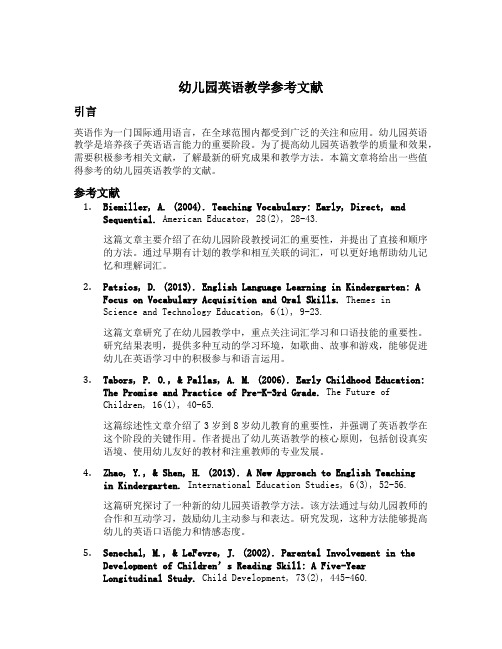
幼儿园英语教学参考文献引言英语作为一门国际通用语言,在全球范围内都受到广泛的关注和应用。
幼儿园英语教学是培养孩子英语语言能力的重要阶段。
为了提高幼儿园英语教学的质量和效果,需要积极参考相关文献,了解最新的研究成果和教学方法。
本篇文章将给出一些值得参考的幼儿园英语教学的文献。
参考文献1.Biemiller, A. (2004). Teaching Vocabulary: Early, Direct, andSequential. American Educator, 28(2), 28-43.这篇文章主要介绍了在幼儿园阶段教授词汇的重要性,并提出了直接和顺序的方法。
通过早期有计划的教学和相互关联的词汇,可以更好地帮助幼儿记忆和理解词汇。
2.Patsios, D. (2013). English Language Learning in Kindergarten: AFocus on Vocabulary Acquisition and Oral Skills. Themes inScience and Technology Education, 6(1), 9-23.这篇文章研究了在幼儿园教学中,重点关注词汇学习和口语技能的重要性。
研究结果表明,提供多种互动的学习环境,如歌曲、故事和游戏,能够促进幼儿在英语学习中的积极参与和语言运用。
3.Tabors, P. O., & Pallas, A. M. (2006). Early Childhood Education:The Promise and Practice of Pre-K-3rd Grade. The Future ofChildren, 16(1), 40-65.这篇综述性文章介绍了3岁到8岁幼儿教育的重要性,并强调了英语教学在这个阶段的关键作用。
作者提出了幼儿英语教学的核心原则,包括创设真实语境、使用幼儿友好的教材和注重教师的专业发展。
英语启蒙教育参考文献
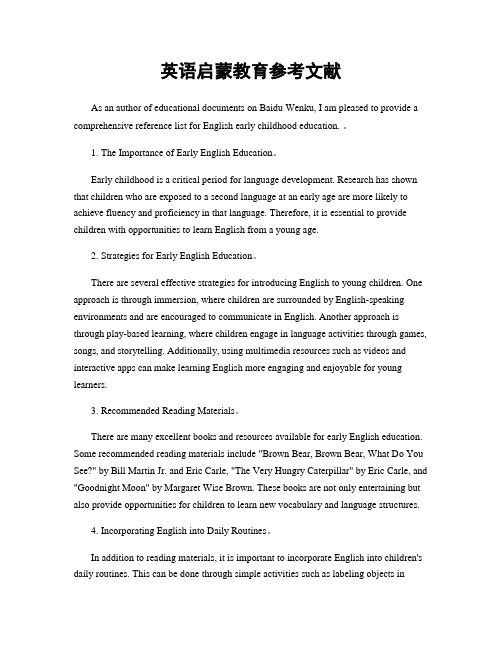
英语启蒙教育参考文献As an author of educational documents on Baidu Wenku, I am pleased to provide a comprehensive reference list for English early childhood education. 。
1. The Importance of Early English Education。
Early childhood is a critical period for language development. Research has shown that children who are exposed to a second language at an early age are more likely to achieve fluency and proficiency in that language. Therefore, it is essential to provide children with opportunities to learn English from a young age.2. Strategies for Early English Education。
There are several effective strategies for introducing English to young children. One approach is through immersion, where children are surrounded by English-speaking environments and are encouraged to communicate in English. Another approach is through play-based learning, where children engage in language activities through games, songs, and storytelling. Additionally, using multimedia resources such as videos and interactive apps can make learning English more engaging and enjoyable for young learners.3. Recommended Reading Materials。
幼儿园大班英语教育参考文献
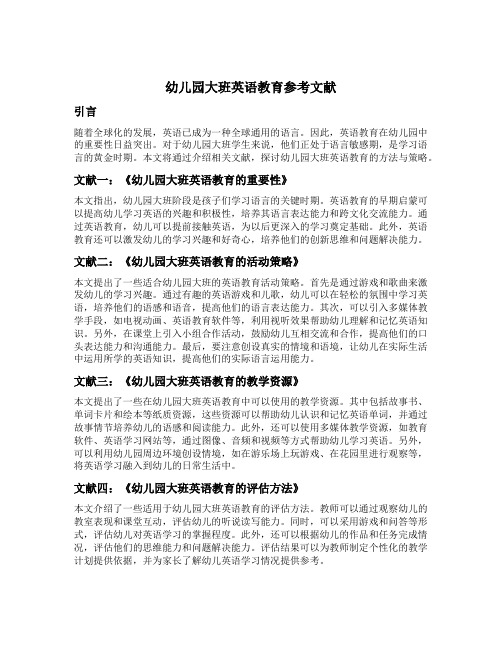
幼儿园大班英语教育参考文献引言随着全球化的发展,英语已成为一种全球通用的语言。
因此,英语教育在幼儿园中的重要性日益突出。
对于幼儿园大班学生来说,他们正处于语言敏感期,是学习语言的黄金时期。
本文将通过介绍相关文献,探讨幼儿园大班英语教育的方法与策略。
文献一:《幼儿园大班英语教育的重要性》本文指出,幼儿园大班阶段是孩子们学习语言的关键时期。
英语教育的早期启蒙可以提高幼儿学习英语的兴趣和积极性,培养其语言表达能力和跨文化交流能力。
通过英语教育,幼儿可以提前接触英语,为以后更深入的学习奠定基础。
此外,英语教育还可以激发幼儿的学习兴趣和好奇心,培养他们的创新思维和问题解决能力。
文献二:《幼儿园大班英语教育的活动策略》本文提出了一些适合幼儿园大班的英语教育活动策略。
首先是通过游戏和歌曲来激发幼儿的学习兴趣。
通过有趣的英语游戏和儿歌,幼儿可以在轻松的氛围中学习英语,培养他们的语感和语音,提高他们的语言表达能力。
其次,可以引入多媒体教学手段,如电视动画、英语教育软件等,利用视听效果帮助幼儿理解和记忆英语知识。
另外,在课堂上引入小组合作活动,鼓励幼儿互相交流和合作,提高他们的口头表达能力和沟通能力。
最后,要注意创设真实的情境和语境,让幼儿在实际生活中运用所学的英语知识,提高他们的实际语言运用能力。
文献三:《幼儿园大班英语教育的教学资源》本文提出了一些在幼儿园大班英语教育中可以使用的教学资源。
其中包括故事书、单词卡片和绘本等纸质资源,这些资源可以帮助幼儿认识和记忆英语单词,并通过故事情节培养幼儿的语感和阅读能力。
此外,还可以使用多媒体教学资源,如教育软件、英语学习网站等,通过图像、音频和视频等方式帮助幼儿学习英语。
另外,可以利用幼儿园周边环境创设情境,如在游乐场上玩游戏、在花园里进行观察等,将英语学习融入到幼儿的日常生活中。
文献四:《幼儿园大班英语教育的评估方法》本文介绍了一些适用于幼儿园大班英语教育的评估方法。
教师可以通过观察幼儿的教室表现和课堂互动,评估幼儿的听说读写能力。
幼儿园英语教育参考文献
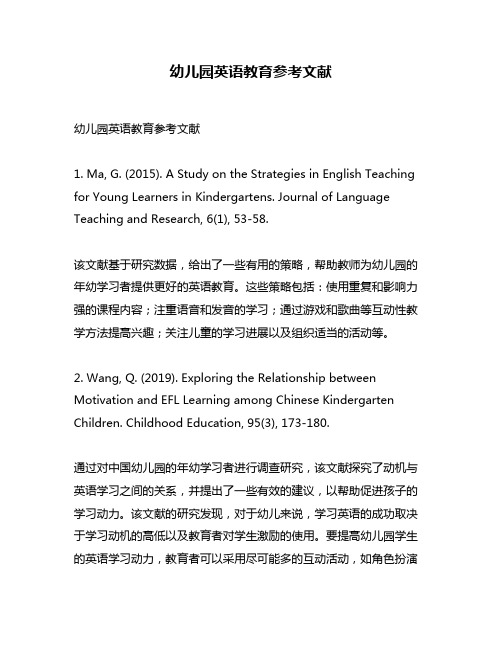
幼儿园英语教育参考文献幼儿园英语教育参考文献1. Ma, G. (2015). A Study on the Strategies in English Teaching for Young Learners in Kindergartens. Journal of Language Teaching and Research, 6(1), 53-58.该文献基于研究数据,给出了一些有用的策略,帮助教师为幼儿园的年幼学习者提供更好的英语教育。
这些策略包括:使用重复和影响力强的课程内容;注重语音和发音的学习;通过游戏和歌曲等互动性教学方法提高兴趣;关注儿童的学习进展以及组织适当的活动等。
2. Wang, Q. (2019). Exploring the Relationship between Motivation and EFL Learning among Chinese Kindergarten Children. Childhood Education, 95(3), 173-180.通过对中国幼儿园的年幼学习者进行调查研究,该文献探究了动机与英语学习之间的关系,并提出了一些有效的建议,以帮助促进孩子的学习动力。
该文献的研究发现,对于幼儿来说,学习英语的成功取决于学习动机的高低以及教育者对学生激励的使用。
要提高幼儿园学生的英语学习动力,教育者可以采用尽可能多的互动活动,如角色扮演和演讲等,以激发幼儿的学习动机。
3. Li, W. (2020). An Investigation into Parents’ Attitudes towards English Education in Kindergarten. Journal of Early Childhood Education Research, 9(2), 29-38.该文献基于对不同家庭家长的调查,分析了他们对幼儿园英语教育的态度和看法。
幼儿教育英文论文文献

LET’S EXAMINE SOME STRUCTURAL PLANNING PRINCIPLES
Infant Room Refer to the web-link I provided you with
Toddler Room Refer to the web-link I provided you with
Toddlers can run, walk, push, pull, climb, and jump. Ensure the outdoor play space has: A variety of surfaces and range of equipment such as: Balls, wagons, buckets, baskets Low easels with chalk or paint Boxes and brushes for painting with water Sand boxes and sand toys Small slides and rocking toys
Knowing that infants enjoy spending time outdoors is important when considering what you will do outdoors with them. You must be mindful of: How you will get them outdoors Having designed areas outdoors where infants can reach, grasp, kick and roll. Providing soft places such as grass, colourful blankets or mats and elevated swings where infants can enjoy the scenery. For Older infants you can provide: Mats, boxes, tunnels Containers for filling and dumping Plastic rails for holding on to.
幼儿园大班英语教育参考文献
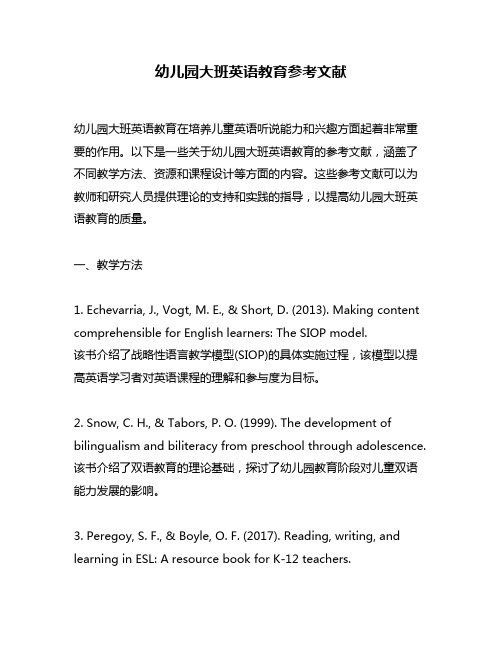
幼儿园大班英语教育参考文献幼儿园大班英语教育在培养儿童英语听说能力和兴趣方面起着非常重要的作用。
以下是一些关于幼儿园大班英语教育的参考文献,涵盖了不同教学方法、资源和课程设计等方面的内容。
这些参考文献可以为教师和研究人员提供理论的支持和实践的指导,以提高幼儿园大班英语教育的质量。
一、教学方法1. Echevarria, J., Vogt, M. E., & Short, D. (2013). Making content comprehensible for English learners: The SIOP model.该书介绍了战略性语言教学模型(SIOP)的具体实施过程,该模型以提高英语学习者对英语课程的理解和参与度为目标。
2. Snow, C. H., & Tabors, P. O. (1999). The development of bilingualism and biliteracy from preschool through adolescence. 该书介绍了双语教育的理论基础,探讨了幼儿园教育阶段对儿童双语能力发展的影响。
3. Peregoy, S. F., & Boyle, O. F. (2017). Reading, writing, and learning in ESL: A resource book for K-12 teachers.该书提供了针对英语学习者的阅读、写作和学习教学的丰富资源,可帮助教师设计有效的英语课程和活动。
二、资源和工具1. Carter, R., & Nunan, D. (2001). The Cambridge guide to teaching English to speakers of other languages.该书提供了教师在课堂上使用的各种教学资源和工具,包括教学材料、游戏和课堂活动等。
幼儿园中班英语教育参考文献
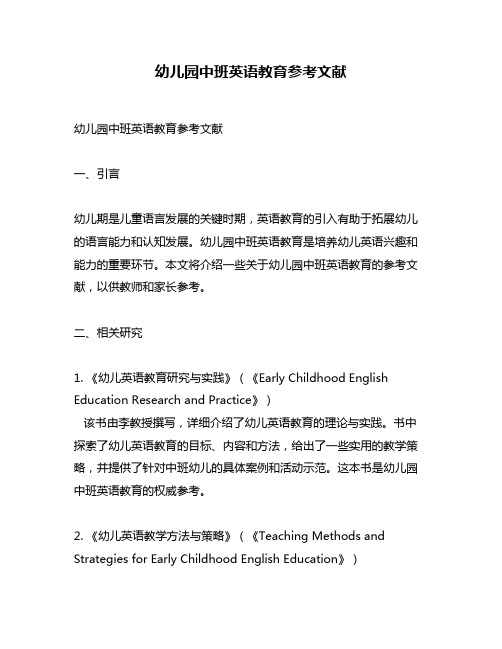
幼儿园中班英语教育参考文献幼儿园中班英语教育参考文献一、引言幼儿期是儿童语言发展的关键时期,英语教育的引入有助于拓展幼儿的语言能力和认知发展。
幼儿园中班英语教育是培养幼儿英语兴趣和能力的重要环节。
本文将介绍一些关于幼儿园中班英语教育的参考文献,以供教师和家长参考。
二、相关研究1. 《幼儿英语教育研究与实践》(《Early Childhood English Education Research and Practice》)该书由李教授撰写,详细介绍了幼儿英语教育的理论与实践。
书中探索了幼儿英语教育的目标、内容和方法,给出了一些实用的教学策略,并提供了针对中班幼儿的具体案例和活动示范。
这本书是幼儿园中班英语教育的权威参考。
2. 《幼儿英语教学方法与策略》(《Teaching Methods and Strategies for Early Childhood English Education》)该书由王教授编写,系统地介绍了幼儿英语教学的多种方法和策略。
书中包含了教师可以采用的多种游戏、歌曲、故事等教学资源,并提供了实用的教学技巧和评估方法。
这本书适合作为中班英语教师的参考教材。
3. 《幼儿园中班英语教育课程设计与实施》(《Curriculum Design and Implementation of English Education in Kindergarten》)该论文由教育学硕士杨女士撰写,研究了幼儿园中班英语教育课程设计与实施的问题。
论文中详细介绍了中班幼儿英语教育的课程设置、教学活动设计和教学评估方法,并给出了一些实例和案例。
这篇论文对于教师们理解幼儿园中班英语教育的课程设计和实施具有指导作用。
4. 《幼儿园中班英语教学模式研究》(《Research on English Teaching Models for Kindergarten Middle Class》)该研究论文由教育学博士陈先生撰写,探讨了幼儿园中班英语教学的各种模式。
幼儿园英语教育指导参考文献
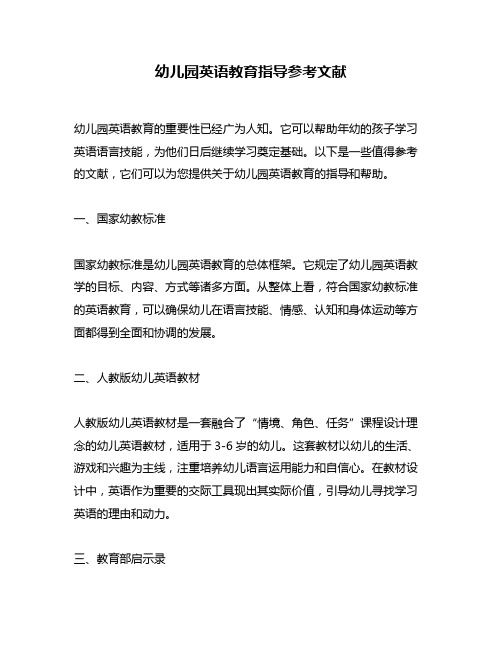
幼儿园英语教育指导参考文献幼儿园英语教育的重要性已经广为人知。
它可以帮助年幼的孩子学习英语语言技能,为他们日后继续学习奠定基础。
以下是一些值得参考的文献,它们可以为您提供关于幼儿园英语教育的指导和帮助。
一、国家幼教标准国家幼教标准是幼儿园英语教育的总体框架。
它规定了幼儿园英语教学的目标、内容、方式等诸多方面。
从整体上看,符合国家幼教标准的英语教育,可以确保幼儿在语言技能、情感、认知和身体运动等方面都得到全面和协调的发展。
二、人教版幼儿英语教材人教版幼儿英语教材是一套融合了“情境、角色、任务”课程设计理念的幼儿英语教材,适用于3-6岁的幼儿。
这套教材以幼儿的生活、游戏和兴趣为主线,注重培养幼儿语言运用能力和自信心。
在教材设计中,英语作为重要的交际工具现出其实际价值,引导幼儿寻找学习英语的理由和动力。
三、教育部启示录教育部启示录是为各级幼儿园英语教育工作制定的指导文件。
它对幼儿园英语教育的内容、课程、教学方法等都做了非常具体的规定。
教育部启示录还为幼儿园英语教育提出设区别于小学英语教育的基本要求,引导幼儿学好英语,做到实用与真实。
四、我国幼儿英语教育政策我国从2004年开始实行“双语教育”,强调将英语作为与母语平等的语言,逐渐将英语教育纳入学校教育体系。
此外,我国政府在教育事业中不断加强对幼儿英语教育的支持,注重提高幼儿英语课程的质量,进一步完善教育市场的保护机制,减少市场失范因素,鼓励更多有专业素养的教育机构从业。
五、海外教材和教育经验从英美等国家的幼儿英语教育经验和教材中,我们可以学习到很多有益的做法和方法。
比如,针对幼儿的语言和认知发展特点,合理地设置课程难度,采用丰富多样的教学方式和手段,强调幼儿园英语教育与游戏、音乐、艺术等领域的融合。
六、关于幼儿英语学习时间表《美国儿童英语语言学习标准》或称CEFR,是一组针对英语学习者的语言水平标准。
英语水平被划分为六个级别,从最基本的A1级别到最高水平的C2级别。
幼儿园中班英语教育参考文献
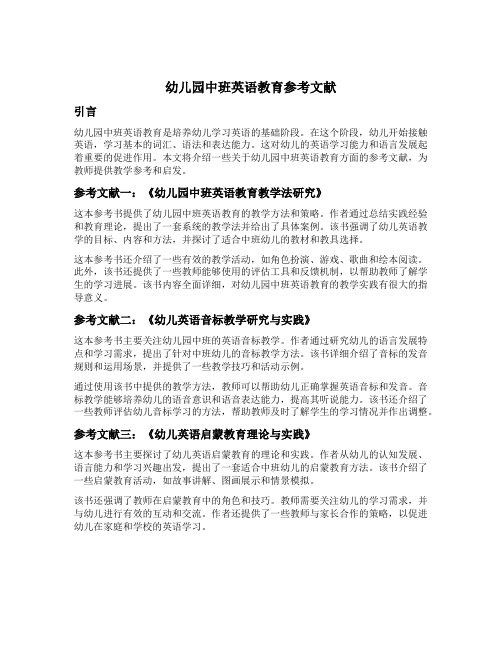
幼儿园中班英语教育参考文献引言幼儿园中班英语教育是培养幼儿学习英语的基础阶段。
在这个阶段,幼儿开始接触英语,学习基本的词汇、语法和表达能力。
这对幼儿的英语学习能力和语言发展起着重要的促进作用。
本文将介绍一些关于幼儿园中班英语教育方面的参考文献,为教师提供教学参考和启发。
参考文献一:《幼儿园中班英语教育教学法研究》这本参考书提供了幼儿园中班英语教育的教学方法和策略。
作者通过总结实践经验和教育理论,提出了一套系统的教学法并给出了具体案例。
该书强调了幼儿英语教学的目标、内容和方法,并探讨了适合中班幼儿的教材和教具选择。
这本参考书还介绍了一些有效的教学活动,如角色扮演、游戏、歌曲和绘本阅读。
此外,该书还提供了一些教师能够使用的评估工具和反馈机制,以帮助教师了解学生的学习进展。
该书内容全面详细,对幼儿园中班英语教育的教学实践有很大的指导意义。
参考文献二:《幼儿英语音标教学研究与实践》这本参考书主要关注幼儿园中班的英语音标教学。
作者通过研究幼儿的语言发展特点和学习需求,提出了针对中班幼儿的音标教学方法。
该书详细介绍了音标的发音规则和运用场景,并提供了一些教学技巧和活动示例。
通过使用该书中提供的教学方法,教师可以帮助幼儿正确掌握英语音标和发音。
音标教学能够培养幼儿的语音意识和语音表达能力,提高其听说能力。
该书还介绍了一些教师评估幼儿音标学习的方法,帮助教师及时了解学生的学习情况并作出调整。
参考文献三:《幼儿英语启蒙教育理论与实践》这本参考书主要探讨了幼儿英语启蒙教育的理论和实践。
作者从幼儿的认知发展、语言能力和学习兴趣出发,提出了一套适合中班幼儿的启蒙教育方法。
该书介绍了一些启蒙教育活动,如故事讲解、图画展示和情景模拟。
该书还强调了教师在启蒙教育中的角色和技巧。
教师需要关注幼儿的学习需求,并与幼儿进行有效的互动和交流。
作者还提供了一些教师与家长合作的策略,以促进幼儿在家庭和学校的英语学习。
参考文献四:《幼儿园中班英语教育课程设计与实践》这本参考书主要关注幼儿园中班英语教育的课程设计和实践。
幼儿园小班英语教育参考文献
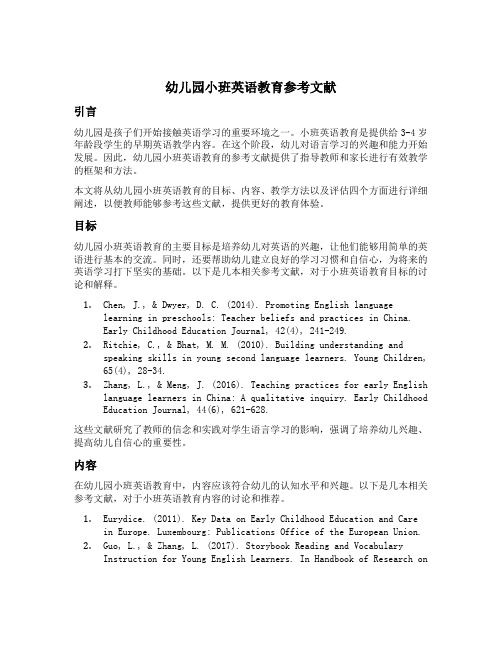
幼儿园小班英语教育参考文献引言幼儿园是孩子们开始接触英语学习的重要环境之一。
小班英语教育是提供给3-4岁年龄段学生的早期英语教学内容。
在这个阶段,幼儿对语言学习的兴趣和能力开始发展。
因此,幼儿园小班英语教育的参考文献提供了指导教师和家长进行有效教学的框架和方法。
本文将从幼儿园小班英语教育的目标、内容、教学方法以及评估四个方面进行详细阐述,以便教师能够参考这些文献,提供更好的教育体验。
目标幼儿园小班英语教育的主要目标是培养幼儿对英语的兴趣,让他们能够用简单的英语进行基本的交流。
同时,还要帮助幼儿建立良好的学习习惯和自信心,为将来的英语学习打下坚实的基础。
以下是几本相关参考文献,对于小班英语教育目标的讨论和解释。
1.Chen, J., & Dwyer, D. C. (2014). Promoting English languagelearning in preschools: Teacher beliefs and practices in China.Early Childhood Education Journal, 42(4), 241-249.2.Ritchie, C., & Bhat, M. M. (2010). Building understanding andspeaking skills in young second language learners. Young Children, 65(4), 28-34.3.Zhang, L., & Meng, J. (2016). Teaching practices for early Englishlanguage learners in China: A qualitative inquiry. Early Childhood Education Journal, 44(6), 621-628.这些文献研究了教师的信念和实践对学生语言学习的影响,强调了培养幼儿兴趣、提高幼儿自信心的重要性。
- 1、下载文档前请自行甄别文档内容的完整性,平台不提供额外的编辑、内容补充、找答案等附加服务。
- 2、"仅部分预览"的文档,不可在线预览部分如存在完整性等问题,可反馈申请退款(可完整预览的文档不适用该条件!)。
- 3、如文档侵犯您的权益,请联系客服反馈,我们会尽快为您处理(人工客服工作时间:9:00-18:30)。
参考文献
[1] 高敏.幼儿英语教育[M].上海:华东师范大学出版社,2007
[2] Flege(1987).A critical period for learning to pronounce foreign language .Applied Linguistics.1993.
[3] [意大利]蒙台梭利.任代文主译校.蒙台梭利幼儿教育科学方法[M].北京:,人民教育出版社,1993年版.
[4] 吴牧之.学前儿童英语教育研究综述[J].中国双语教育网,2004.
[5] [美国]乔姆斯基.乔姆斯基语言哲学文选[M].北京:商务印书馆,1992.
[6] 林泳海.幼儿教育心理学[M].北京:商务印书馆,2007.
[7] 束定芳,庄智象.现代外语教学—理论、实践与方法[M].上海:上海外语教育出版社,1996.
[8] 强海燕,赵琳,西格尔.幼儿英语浸入式教育活动[M].陕西:西安交通大学出版社,2000.
[9] 哈默,田贵森.怎样教英语[M].北京:北京外语教学研究出版社,2002.
[10] 边静.TPR教学法在儿童英语学习中的运用[M].宿州学院学报,2007.8.
[11] 孟云.幼儿园双语教育研究—基于昆明市幼儿园英语教育调查[D].云南:云南师范大学,2006.
[12] 狄飞.幼儿英语浸入式教学的研究与试验[D].甘肃:西北师范大学,2001.
[13] 颜晓芳.学前儿童英语启蒙教育的误区[J].广西教育学院学报,2004,4.
[14] 仲伟秀.幼儿英语教育存在的问题及解决策略[J].呼伦贝尔学院学报,2006,8.
[15] Jack Richard.Longman Dictionary of Applied Linguistics[M]. Longman : Longman press,1985.
[16] John Lybolt,Catherine Gottfried.Promoting pre—school Language[M].INTERNA TIONAL ACADEMY OF EDUCATION,2003.。
